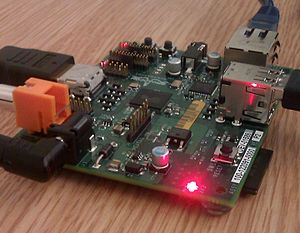
Electronics are getting smaller. Â People don’t have desktops in as large a number as they once did. Many have laptops, netbooks, tablets, etc.
This is an area we’ve been thinking about a lot lately, mostly due to the flood of inexpensive systems on a board, led by the Raspberry Pi. The Pi is a computer the size of a credit card, and the commonly sold version includes RCA video, HDMI video, two USB ports, and an Ethernet Port. The entire assembly is powered by a microUSB charger of the sort bundled with phones and other electronics. The GPU onboard is capable of blu-ray quality playback. There is no built in drive, the OS is loaded off of an SD card. You can hook in a USB drive, but not as a boot drive.
There is a special version of Fedora, Debian, and even an XBMC port to turn the Pi into a full-fledged media center
Now, this won’t be taking the place of a full-fledged PC for many things, but the Pi, and some of the competing devices are perfect for ’embedded system’ type functions.
An embedded system is a computer system designed for specific control functions within a larger system. With something like a Pi, with its pricing, even with the purchase of a case(we mentioned case not included, right?) you can buy multiple Pis and use them to do one thing.
This changes design conceptions a lot. When you are trying to figure out your connected home and life, you can build a Pi to boot, launch a function, and perform it well, just like your cable box(well, like your cable box could be), VoIP phone, etc.
We currently have a quad-core server, that does multiple functions. It does do CPU scaling when idle, but many of the functions could be taken over by a Pi. Using Wake On Lan functionality, the Pi could even wake up the full computer and transfer control to it.
There are a lot of good ideas here. Have a device that does one thing, and nothing else. This would mean incredible long term stability, and because the Pi loads its OS on an SD card, you could have different SD cards to change the Pi’s functionality.
What ideas do you have? We’re just getting started.


